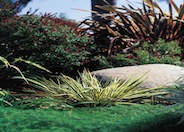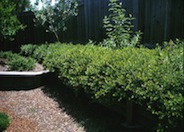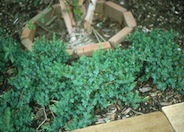
Common name:Allan Bloom Hybrd
Botanical name:Achillea 'Moonshine'
Long, straight stems with pale yellow flowers are apparent on the mats of green to grey-green leaves of this plant, which are flatter and less divided than those of the Achillea millefolium. The yarrow propagate easily from rooted cuttings or division, which should be performed in the early spring or fall. Following bloom, one should dead head the plant and divide the clumps when it appears crowded.

Common name:New Zealand Flax, Wings of Gold
Botanical name:Phormium 'Wings of Gold'
The Phormium is a dwarf, growing to only 2'-3' tall. The stiff, vertical leaves are olive green in color with a yellow margin. It should be grown under full to part sun.

Common name:Manzanita Emerald Carpet
Botanical name:Arctostaphylos 'Emerald Carpet'
The 'Emerald Carpet' is an evergreen groundcover that grows to 1' tall by 6-8' wide. It is favored by many landscapers as the manzanita of choice for inland situations. It has dark green leaves and exhibits compact growth. The variety is relatively tolerant of adverse soil conditions, but requires good drainage. -Monterey Bay Nursery

Common name:Kangaroo Paws, Green
Botanical name:Anigozanthos flavidus
This tender perennial is a clump-forming evergreen that produces fuzzy, yellow green flowers that bloom in spring and last for over 2 months. It comes in other colors, like red also.

Common name:Blue Pacific Shore Juniper
Botanical name:Juniperus rigida conferta 'Blue Pacific'
This is the improved form of the Juniperus conferta, as the growth of this variety is more compact, with foliage that is a rich, blue-green color. Junipers are highly combustible plants.
The Magic of Mulch
In the natural world the endless cycle of birth, growth, decay, death and rebirth flows throughout the seasons. Plants die, leaves fall and new growth springs up in its place. Nothing is lost and the fallen leaves and dead plants decay into the soil, enriching it for the next generation of growth.
Click in the green box for more information
| Designer: | Ascending Platform Steps Entry |
Photographer: GardenSoft |
Soils and Compost:
Physical weed control, including mulching, or hand removal protects the watershed from harmful chemicals.
Integrated Pest Management:
Remove irrigation water and fertilizer from areas where you don't want weeds to grow.

